Previously: “Internet Story” And The Horror Of Real Life.
Every video game system and console has its fair share of unreleased, unfinished, and cancelled games. That’s just the way the proverbial cookie crumbles; not everything that gets greenlit ultimately gets followed through. In the best-case scenarios, games cancelled for one console find new life on another — but some never see the light of day. Like, for instance, Catastrophe Crow, or Crow 64, as it’s sometimes called — so named for its intended console, Nintendo’s N64.
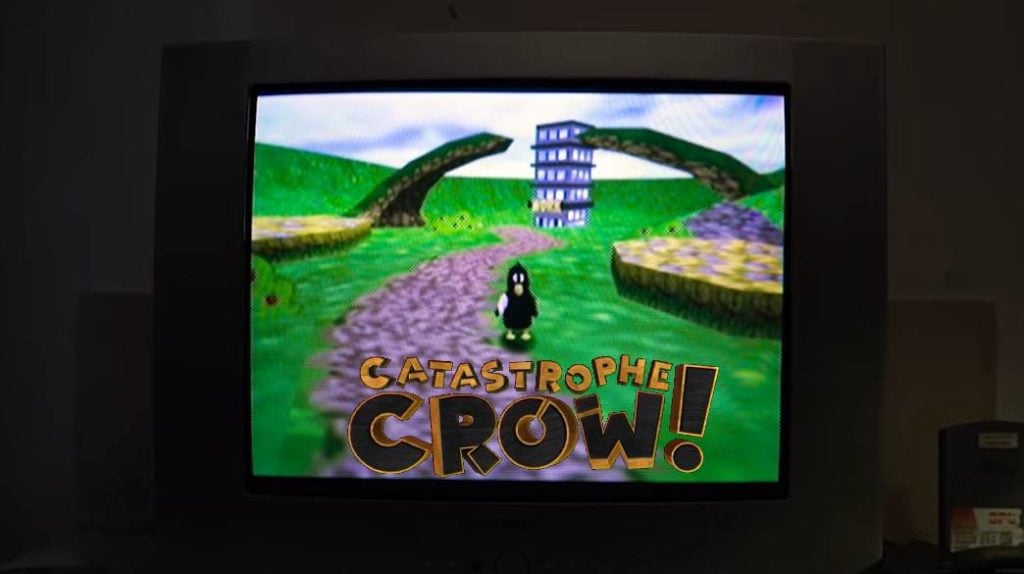
What? You’ve never heard of Catastrophe Crow? Well, you’re not alone; until fairly recently, most people hadn’t — not until the arrival of a short documentary on YouTube on Oct. 15, 2020 titled “What Happened To Crow 64?” This documentary recounted a brief history of Catastrophe Crow’s tragic life and death — and the circumstances surrounding its inception, which may have been even more tragic. Interest in the game and its story have swept the internet in the months since, and with good reason: There seems to much more below the surface here than at first it seems.
[Like what you read? Check out Dangerous Games To Play In The Dark, available from Chronicle Books now!]
Of course, if you haven’t heard of Crow 64 before, there’s actually a good a reason for that: Catastrophe Crow never existed. Nor did its reclusive designer, or his company, or his family, or any of the tragedies that befell them all. The story is a piece of fiction created by filmmaker Adam Butcher, who functions both as a character within the fiction and as its mastermind outside of it.
But there’s more to the whole thing than just this single video. Crow 64, you see, is an alternate reality game — an ARG.
And it’s one of the best ones I’ve seen in recent memory, for the depth of its storytelling and the tale it weaves.
It is, I would argue, a lesson in how to do an ARG right.
Catastrophe Crow And The Locating Of A Trailhead
Let’s start at the beginning — or at least, what looks like the beginning. Here’s what Adam Butcher tells us in our introduction to the ARG, “What Happened To Crow 64?”:
Catastrophe Crow is an unfinished game for the Nintendo 64 that was in development between 1996 and 2001. Helmed by Manfred Lorenz, a German game designer known for his perfectionist tendencies and his 1995 title Ocean Quest, under the umbrella of his development studio, Opus Interactive, Catastrophe Crow took the form of a 3D platformer, much like Mario 64, Banjo-Kazooie, and other similar hits from the N64 era. It was also intended to push the limits of what both the N64 itself and gaming more broadly were capable of achieving.
Lorenz didn’t give many interviews about the game while it was in development, but the few that were published featured glowing reviews of development builds a handful of journalists were given access to. These interviews also included sound bytes that teased groundbreaking elements of the game and highlighted Lorenz’s ethos when it came to his work.
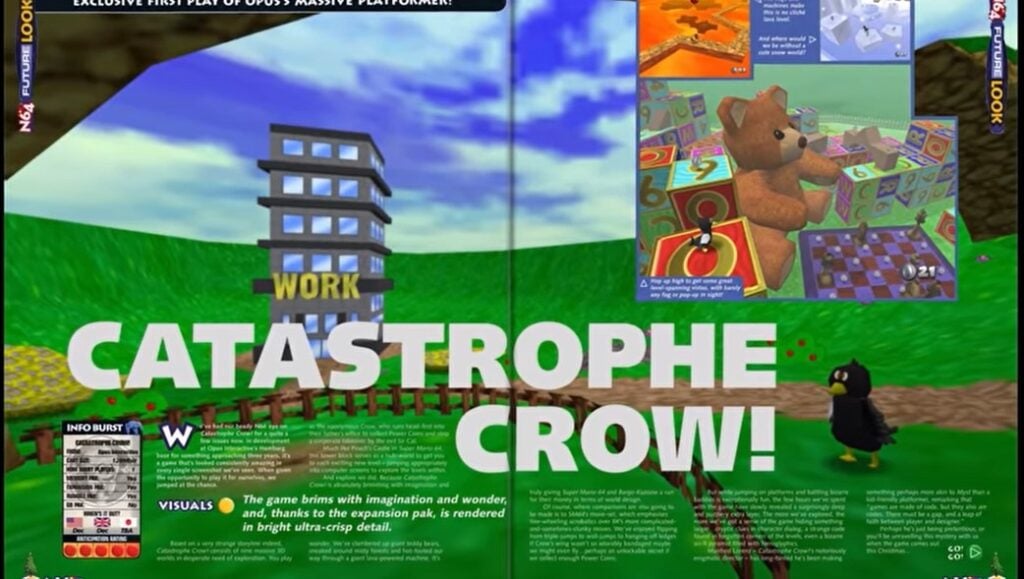
The main player character, initially called “Mr. Crow” before later becoming simply “Crow,” was based on a drawing made by Lorenz’s daughter: An illustration of a black crow with bandages on its head and left wing and a storm cloud and streak of lightning hovering above its head, flanked on either side by an ambulance and a hospital. The game, according to Lorenz, would boast the “fearless exploration of unfamiliar worlds” as you guided Crow — who, notably, could jump, but not fly — through their quest to prevent the corporate takeover of their workplace by the sinister Sir Cat. Also present was what Lorenz called an “Eternal Revival System” — a gameplay convention where, instead of suffering a coin-op arcade game-style “game offer” upon death, the player character’s “soul remain[ed] constant,” with “the world around you inevitably [changing]” each time you came back to life.
Lorenz himself viewed his work somewhat cryptically. “Games are made of code,” he said according to one interview, “but they also are codes. There must be a gap, and a leap of faith between player and designer.”
When Catastrophe Crow was first announced, it was planned for a Christmas 1999 release. But then it was pushed back a few months — and then a few more months — and then a few more — and then a few more. Lorenz racked up millions in debt working on the game, which continued not to surface. He stopped going home. He took more and more control over the development. He instructed designers to create increasingly bizarre-looking assets without telling them what they were for. And, according to one disgruntled Opus Interactive employee writing anonymously on an online forum, there was now “something” in the game that Lorenz hadn’t intended to be there at all — something he’d “unintentionally created,” as Butcher describes it, and which seemed to be taking on a mind of its own.
When urged by his team to “think of the player” and just release the game already, Lorenz said only, “The player is gone.”
The release of the next generation console in Nintendo’s lineup, the Game Cube, in the fall of 2001 was the final nail in Catastrophe Crow’s proverbial coffin. By that point, Lorenz had already laid off Opus Interactive’s entire staff; he couldn’t afford to pay them anymore. He continued working on the game himself, it was believed, locked up alone in the offices where Opus Interactive had once thrived — but when debt collectors eventually went to those offices, they found Lorenz and all of his equipment gone. He wasn’t at home, either — and neither was his family. His wife, it was discovered, had left the country six months earlier.
His sail boat was later found floating off the coast of Germany in the North Sea, abandoned. He was believed dead; what else could readers take away from the defeated-sounding note he had left addressed to his wife, Marta?
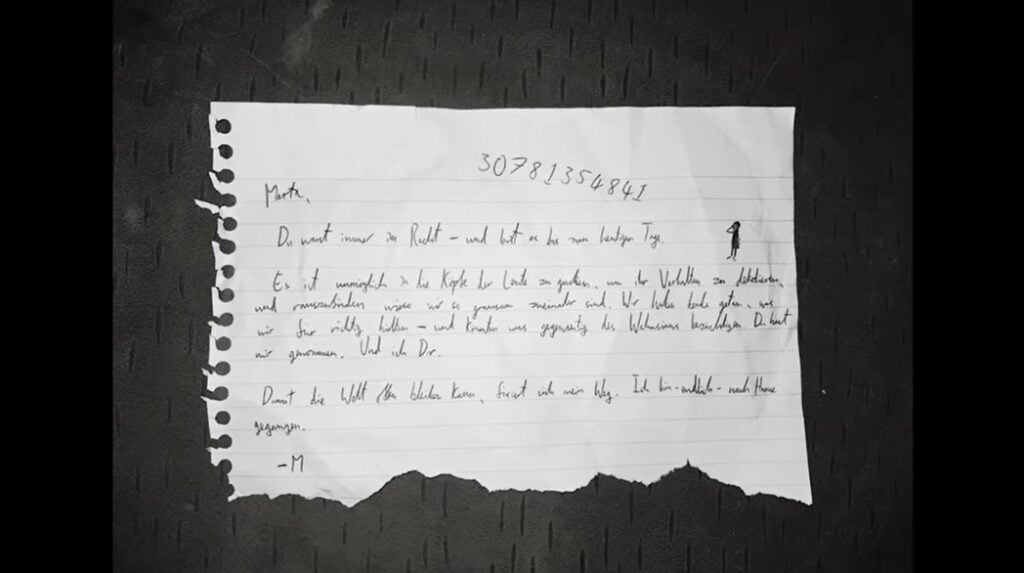
And that, seemingly, was where the history of Catastrophe Crow ended. From there, Butcher reveals that he has managed to acquire a development cartridge of the unfinished game through an eBay auction — and the rest of the video is gameplay footage.
We watch Crow wander around the main hub world, which contains their workplace and their home, in addition to seeing them explore different “worlds,” like one made of oversized blocks and other children’s toys. Quickly, though, things get… weird. And not just in a “this game is unfinished; of course bits of it are going to be buggy” sort of way. Beyond the glitches and the clipping and texture issues, we begin to see a number of rather unsettling images and scenes: A crow holding computing equipment and jumping off a boat into a black void; an older crow standing by an open grave, sobbing; strange monsters whose appearance is quite different from the cartoony style in which the rest of the game is rendered looming out of the fog; a staircase, and Crow tumbling down it; a phone ringing persistently; and — finally — a scene in which we’re no longer Crow, but the older crow we saw sobbing at the graveside. This older crow enters the house present in the hub world. He climbs the stairs. He enters a room that looks as if it belongs to a child; crayon drawings hang on the walls, strewn about the space are normal-sized versions of the oversized toys we saw earlier.
There’s a younger crow in the bed — a headless crow, hooked up to some sort of medical machine.
The young crow struggles to breathe.
Water begins to fill the room.
And then, a monster emerges from the wall, grabs the young crow, and pulls it off into the darkness as it screams.
There’s already a lot here to unpack — but this video, it turned out, was just the start.
It soon emerged that there were… other videos.
Shortly after the arrival of “What Happened To Crow 64?”, viewers discovered at least nine other videos spread across six different YouTube channels also contained relevant information. What’s more, these channels, although scant on content, had been around for nearly a year and a half already at the time of their discovery: They were all created between April 22 and May 20, 2019, and their Crow 64 videos had been uploaded between July 19 and Oct. 8, 2020. (They also each contained at least one other retro gaming video, typically uploaded the day each account was created.) Furthermore, in the weeks and months following the Oct. 15 drop of “What Happened To Crow 64?”, four more videos arrived on one of the six channels.
It quickly became clear that “What Happened To Crow 64?” wasn’t the first Catastrophe Crow video to be released. But it was the most important of the videos: It was, in the language of ARGs, the trailhead for the Crow 64 game as a whole.
Stories About The Internet — And Much More
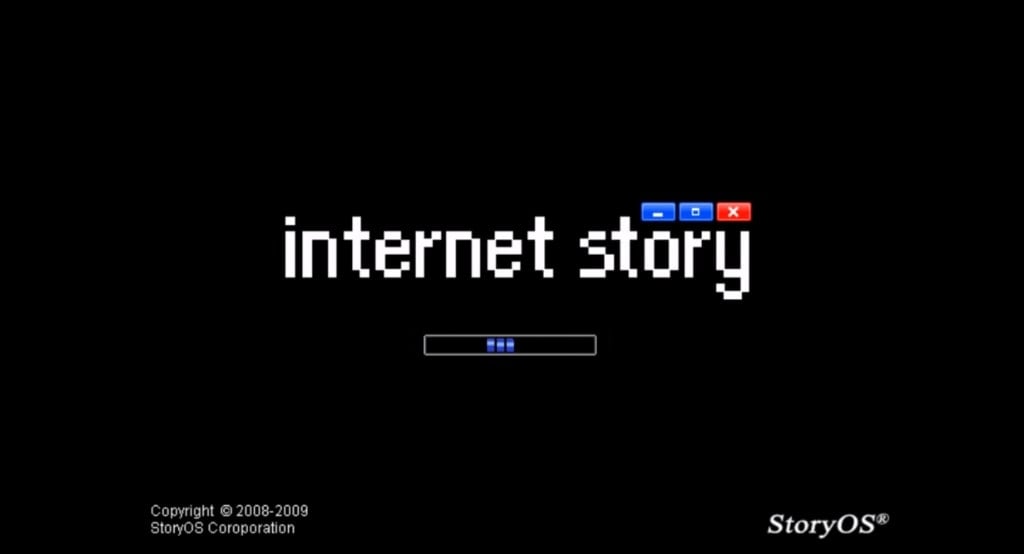
Outside of the story, all of the additional channels and videos were, of course, created by Adam Butcher himself; remember, we’re dealing with a piece of fiction here. But in-universe, they’re their own thing — that is, in the continuity of the story, they were created by someone else. In many ways, this isn’t a surprise, and not just because the existence of multiple channels containing different elements of the story is a hallmark of ARGs in general. In this case, it’s not a surprise because we’ve seen this kind of thing from Butcher before. In fact, I’d argue that the Catastrophe Crow saga is a more sophisticated version of the same sort of storytelling that also characterized Butcher’s earlier work — the natural progression of it, if you well.
Butcher is probably best known for his 2010 short film “Internet Story,” which went viral not too long after its initial release. (It was first put out on Vimeo in 2010, then on YouTube the year after). And although it actually was pretty clear from the get-go that “Internet Story” was, in fact, a piece of fiction told in a documentary-esque style, rather than an actual documentary, what struck so many about it — what became one of the primary the reasons for its wide and rapid spread — was that it looked so real.
As would later be the case with Catastrophe Crow, Butcher created numerous assets that play key parts in “Internet Story” quite far in advance of the film’s release, scattering them across the internet like so many breadcrumbs. These assets — namely, the “Al1’s Nine Grand Quest” website and Fortress’ YouTube account — gave those who felt like looking a little deeper into the whole thing a few extra elements to explore. But the actual narrative of “Internet Story” didn’t rely on viewers investigating the website or the YouTube channel to communicate the complete tale. The film was about a game, and it included a few game-like elements — but it was mostly just a film, something meant to be watched and perhaps thought about, but not necessarily “played” or “solved.”
Crow 64, meanwhile, takes the format and conventions Butcher started playing with in “Internet Story” — and employs a few of the skills that are on display in his 2014 video “The Game That Time Forgot” — and took them to a whole new level. First off, he made a game around which to base the story and to use as a vital storytelling mechanism, similarly to what retro spooky video game web series favorite Petscop did between 2017 and 2019. Then, he seeded tons of other videos and bits of information across the internet before he even published “What Happened To Crow 64?” — and he hid the main story, the big picture, in such a way that we can only experience it fully by assembling all of these pieces together ourselves.
He didn’t just make a film about a game; he made a game, and then he made film about that game that is itself another game — and which, ultimately, reveals a story that’s about much more than just the original game.
It’s sort of a game-ception situation, if you will.
And it’s all of this that makes the Catastrophe Crow saga so satisfying. Butcher knows what he’s doing. This isn’t a slapdash, make-it-up-as-you-go-along hobby project; he’s literally a pro, and he mapped out everything to make sure it was going to be satisfying to casual viewers and deep dive players alike.
“What Happened To Crow 64?” is the beginning of a story that starts in medias res.
It’s intended to point us in the right direction.
And does it ever.
Hidden Messages And Games As Codes
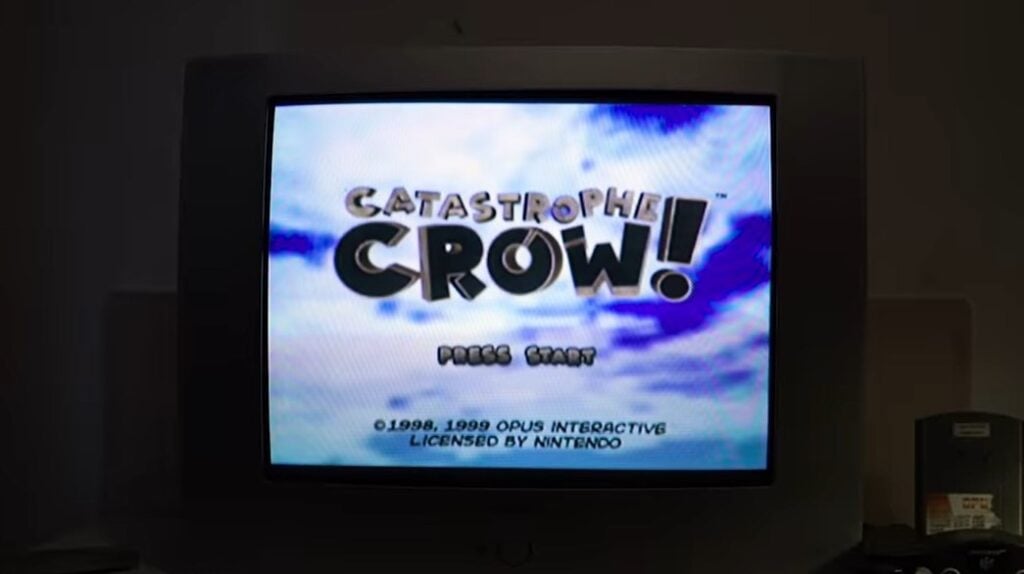
So what is the story? What did happen to Crow 64?
Let’s explore.
Shortly after watching “What Happened To Crow 64?”, many viewers started doing what comes naturally to most of us in the age of the internet: They started searching YouTube more generally for “Catastrophe Crow” and “Crow 64” hoping to pull up more information about this supposed long-lost game — that is, they did exactly what they were supposed to do following the discovery of an ARG trailhead. In doing so, they began to bring to light the other videos and channels featuring footage of the unfinished game — and, gradually, to bring the greater story resting within the depths of Catastrophe Crow into focus, both through the visuals of the gameplay itself and through the puzzles and coded messages scattered throughout. (Here’s a full playlist of all known Crow 64 videos so far.)
There’s been an extremely active community working together on Discord and Reddit to solve the ARG down to every last detail; if you want to get in on the action, head there. This intrepid group of puzzle-solvers has also put together a vast Google doc assembling all of the findings they’ve made so far, which is a must-read for getting started. It’s not a quick read — at the time of this writing, it’s 75 pages long and will likely only continue to grow — but it contains everything that’s been solved so far, along with a lot of solid speculation about what the meaning of the whole thing is.
In any event, the visuals, I would argue, give the narrative form and paint it in broad strokes; meanwhile, the puzzles, when solved, fill in some of the details and advance the plot, insofar as there is one.
In terms of the visuals, we come to learn that Crow is not the only avian character in Catastrophe Crow; there is, in fact, a whole family of corvids, including Father Crow (the older, spectacles-wearing crow we previously saw in Butcher’s video) and Brother Crow — who, unlike Crow themself, is uninjured and has the ability to fly as well as jump.
We learn that this family of crows represents Manfred Lorenz’s family: Crow is his daughter, and the inspiration for the game; Father Crow is Lorenz himself; and Brother Crow is his younger child, a son, who isn’t mentioned at all in “What Happened To Crow 64?” But we learn, too, that two other, nightmarish creatures that sometimes emerge from the mist and fog and darkness of the game’s environments also represent members of the Lorenz family: “Scarecrow” and “Crawler,” who both have bags over their heads, seem to stand in for Lorenz’s wife, Marta — who doesn’t have a crow equivalent in the game — and their son in a secondary form.
We learn through the way these characters appear and disappear, the way they interact with each other and their surroundings, and the way their environments shift and change that something seems to have happened to Lorenz’s daughter — that is, to Crow: She became ill or injured — or perhaps always was ill or injured — and, possibly, died.
We learn that, during her illness and following her death, Lorenz became more and more withdrawn. We learn that he grew more and more obsessive over Catastrophe Crow, spending less and less time and home until the concept of “home” vanished for him entirely. We learn that both of these things — the death and the obsession — tore what remained of the family apart.
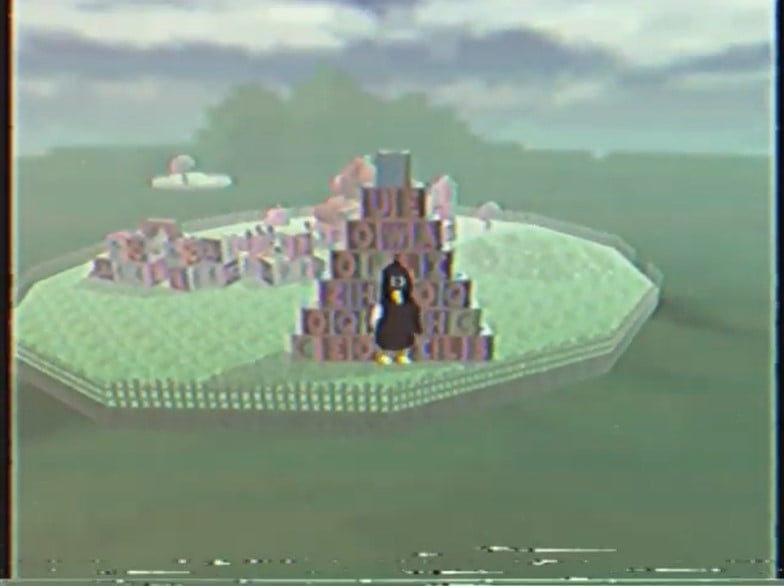
Meanwhile, we also see a variety of coded messages pop up throughout each of these videos — and, if we look carefully, we can find the keys for decoding each of these messages, as well.
This is where the Crow 64 community really shines, by the way; for the nitty-gritty of each and puzzle and every tiny detail, head on over to the Catastrophe Crow Google doc, but in the meantime, here’s a brief over of the most important puzzles and the information that’s arisen from them.
Four ciphers have been found in use across the entire ARG — the “Crow language” cipher, which is a simple, one-for-one letter substitution code; the Vigenère cipher, which uses numbers and letters in conjunction with a table and specific keywords to decode texts; a one-for-one sound cipher, where noises and sound effects stand in for each letter; and a second one-for-one sound cipher that uses musical notes and tones as to represent the letters.
The Crow language cipher’s key is contained within the “catastrophe crow n64 playthrough” video on the channel N64 Long Lost Lore, which was uploaded to YouTube on Sept. 20, 2020. The “Forest Level” video on the channel N64ExcavationMan, uploaded on Sept. 29, contains the table for decoding the texts that use the Vigenère cipher. Known keywords so far are “Nils,” “Thea,” and “Crow.” The “Catastrophe Crow! – Underground Level” video, which arrived on the channel Childhood Memories 64 on July 19, holds the key to the first sound cipher; the footage literally shows Crow hopping around on a giant keyboard, with each letter playing a specific sound. And lastly, the “End Credits Soundtrack (1995)” video on the channel Ultra 64 Forever, which hit YouTube on Oct. 8, holds both the second sound cipher message and its key.
When solved, the messages coded with these ciphers give us even more information. We learn, for instance, that Lorenz’s daughter is named Thea, and his son, Nils. (Notably, in “Crow language,” “Thea” is “Crow”; “Crow” is “Nils”; and “Nils” is “Thea.”) We also get drips and drabs of other messages — phrases like, “I am sorry I could not be with you in the end” and “Please forgive me my little crow.”
These messages don’t seem to mean much on their own — but to make sense of them, all we have to do is return to the original video: Butcher’s own “What Happened To Crow 64?” documentary, which, it turns out, serves not only as the trailhead, but also the key to understanding the ARG’s story as a whole.
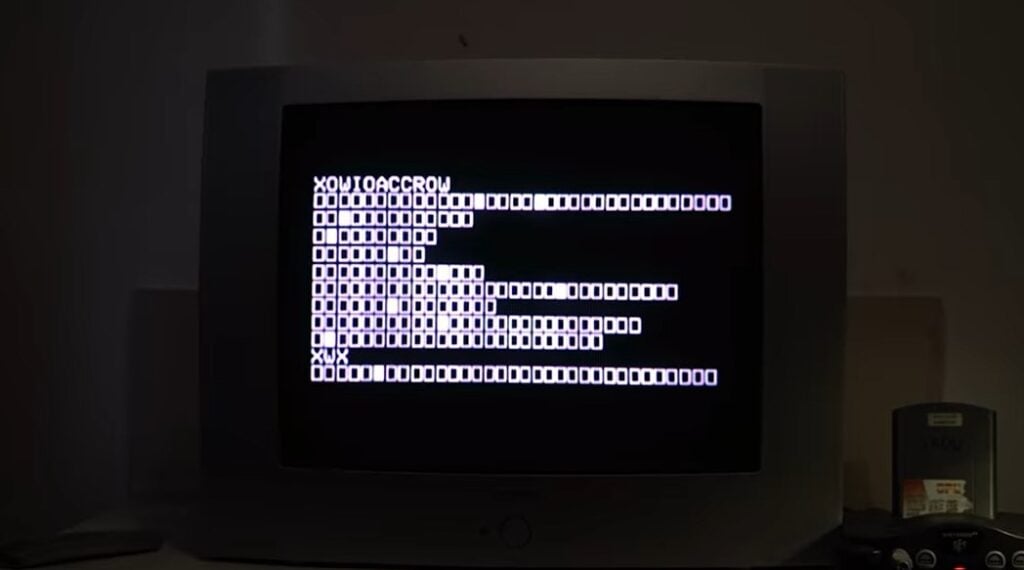
You see, the unusual boot screen we see right when Butcher begins the gameplay portion of the video contains a message — one that requires us to patch together each of the individual messages decoded from the other Crow 64 videos in order to make up the whole. The boot screen itself gives us the first and the second-to-last lines in the message; then, each of the missing lines are supplied by the other videos, with the lines’ positions determined by the number of characters they hold. Taken together, and decoded from Crow language, we can read the following:
“Dearest Thea
I am sorry I could not be with you in the end
I was too afraid
I ran and now
I am in hell
One I made myself
I dreamed of you playing this one day
But you never will
Please forgive me my little crow
Please forgive me both of you
Dad
This is only for your little brother now”
But that’s not all; there’s a second message here, too. You’ll notice that in the boot screen, several of the boxes are filled in. When pulled out and placed together, the letters that correspond to these boxes form the phrase, “Dearest Nils.”
The story becomes clearer. It underlines the story we unraveled from the gameplay itself — and now, we get a hint of what the big picture might be, what the point of Catastrophe Crow could be as a whole. Lorenz seemingly began making the game for Thea, but as she became sicker, he, unable to face reality, buried himself in his work instead of spending what little time his daughter had left with her—and when she died, he wasn’t there for her, literally or metaphorically. This, perhaps, is what Lorenz meant when he told one of his employees all those years ago, “The player is gone”: The player was meant to be Thea, but after her death, the player was no more.
His absence became his biggest regret — but, seemingly, the development of the game didn’t end there.
It went on.
But it’s no longer for Thea.
Now, it’s for Nils — for Lorenz’s son, who is still alive and, presumably, an adult by now, some 20 years later.
Moving Outside The Box
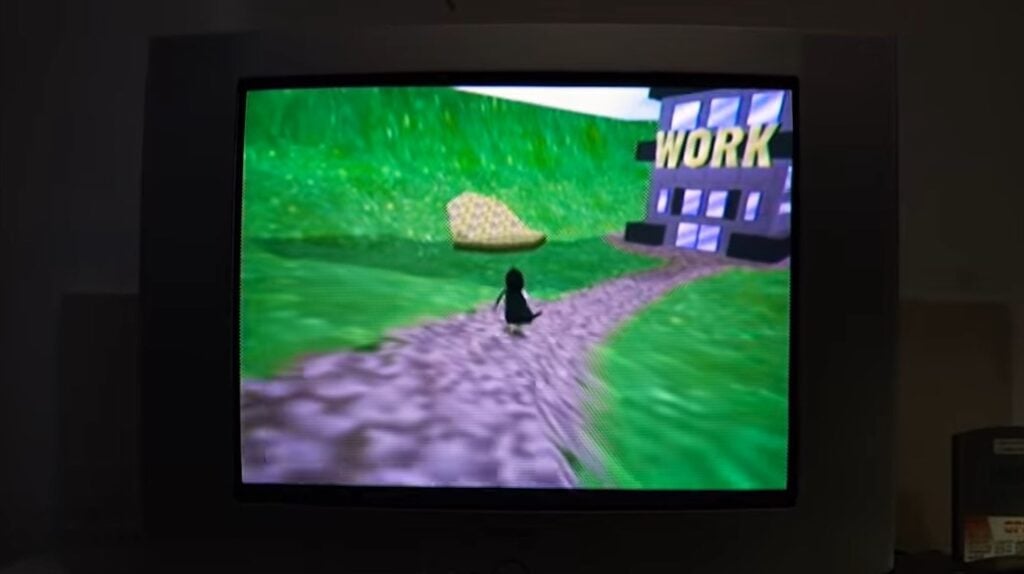
But there’s more — more left to complete the story, to flesh it out fully.
Consider, astonishingly, this possibility:
Manfred Lorenz, who seemingly jumped off his own boat and died by suicide… may not be dead after all.
You see, there are other codes, too — ones that aren’t found within the smattering of Crow 64 videos published across YouTube, but which are still very much connected to them by way of their actual channels.
Several of these channels — N64 Long Lost Lore, 90sRetroGamingFRed, 3D Platformers NZ, and N64ExcavationMan — list email addresses on their “About” pages; meanwhile, the channel Childhood Memories 64 doesn’t have an email address listed, but does include the following line: “Remember this cheat code?: 7689-422697-89-60951.” When decoded using the Vigenère cipher with the keyword “Nils,” the “cheat code” reads, “Join-Emails-In-Order.” Viewers and players of the Crow 64 saga accordingly strung together all of the emails listed for the other channels and fired off messages to it — and received messages in return, seemingly from none other than Manfred Lorenz himself.
Players unearthed the email address within days of the publication of “What Happened To Castrophe Crow?”, and on Oct. 17, the address began responding to those who had reached out to it. Initially, the correspondent, who signed themself “M L,” asked simply, “Who is it?” If players responded with “Nils,” M L replied back with various iterations of the following message:
“My dearest boy,
After all these years I have much to say,
Your birthday is not too far from now. I hope we can meet the day after? In the place we holidayed every year?
I will be there.
M”
So far, no one has correctly identified Nils’ birthday or the place where the family holidayed every year; incorrect response all yielded variations on the following message:
“I wish to believe you, but can no longer make the leap.
I understand now that this has met many more eyes then those for which it was intended. I can only hope the true recipient is among them
I will be waiting”
M L uses this phrasing — “making the leap,” “taking a leap of faith” — frequently in his responses, echoing, perhaps, what Lorenz noted in that long-ago interview: “Games are made of code,” he had said, “but they also are codes. There must be a gap, and a leap of faith between player and designer.”
The thought did occur to players that perhaps the emails they received weren’t from Manfred, but from Marta; Manfred and Marta do both have the same initials, after all. But signs generally point to Manfred being the correspondent — and not just from the content of the emails.
Look at the last few letters of the four channels used to find M L’s email address:
N64ExcavationMan
90sRetroGamingFRed
N64 Long Lost Lore
3D Platformers NZ
Now, line them up together:
Man FRed Lore NZ.
Manfred Lorenz.
And, in case you need something even more concrete, return again to “What Happened To Crow 64?” and look at the note Lorenz left before abandoning his boat. There’s an 11-digit number scrawled at the top — 30781354841 — which, when decoded with the Vigenère cipher, yields three different messages, depending on which word you use as the keyword: Using “Thea” reveals the message, “Is not for you”; using “Crow” reveals “For other kin”; and using “Nils” reveals, “Nils I’m alive.”
The replies ceased quickly, however, with no further responses arriving after Oct. 21. Anyone who had emailed the address — whether they had previously received a response or not — did receive a strange audio file on Dec. 5, which, when decoded, presented an image of a pyramid; beyond that, though… well, this is the where the trail goes cold at present.
The Story Of Crow 64

The videos aren’t the only pieces of information we’ve gotten over time, by the way. At one point, a person claiming to be a former employee of Opus Interactive, Ulrich Aderman, came forward on both Twitter and YouTube with some design and development documents from Catastrophe Crow, as well as a data dump of assets extracted from a workstation used to build the game. (For the curious: Yes, accessing the data dump required players to figure out the correct password.) There’s plenty in this data dump to sift through for the detail-oriented, and, again, the Discord community has been quite active on that front; they’ve been compiling their findings in an entirely separate document which is now 26 pages long and counting.
However, I’ve found that most of these details serve simply to underline and sharpen what we already know — the file names sometimes tell us how we should read or interpret certain assets; some images and motifs we’ve seen before appear again, coded in certain files, emphasizing their importance; and so on and so forth.
I also don’t know that, barring more emails from M L, there will be any further information drops. It seems to me that, at this point, we have everything we need to figure out what exactly the rest of the story is; we just need to decode all the pieces and put them together in the correct way.
As I see it, the story of Manfred Lorenz and Catastrophe Crow is this:
Inspired by his daughter, Thea, Manfred Lorenz began development on what was intended to be a groundbreaking Nintendo 64 game, Catastrophe Crow, in 1996. Thea was either already ill or injured at the time development began or became so quickly thereafter; either way, she worsened as time went on. In his grief over Thea’s deteriorating health, Lorenz pulled away not only from her, but also from his wife, Marta, and his younger child, Nils, throwing himself into the development of Catastrophe Crow instead: If he could just finish making this extraordinary game — if he could present his daughter with it, if he could make something special just for her to play — maybe he could heal her. Maybe he could prolong her life through the act of making this game.
But he was unable to do so. He failed, and Thea died without ever playing Catastrophe Crow. But following his failure, Lorenz changed tack: Thea would never play the game he had originally begun making for her — but maybe he could use that very game to ensure that she would live on forever. He already had an “Eternal Revival System” built into it, after all; who’s to say what this system could be capable of, if one were willing to get… creative about it?
Time, however, was running out. Marta had already left, presumably taking Nils with her — and as the N64 era ended and the debt collectors came calling, Lorenz did the only thing he could think of to escape his mounting problems: He faked his own death and secreted himself away, giving himself the time and the space to continue perfecting the game.
But the game wasn’t for Thea anymore. It was for Nils.
It was so Nils, who had been so young at the time, could finally understand what had happened to his family.
It was so Nils could continue living for his sister, whose life had ended so early.
And, perhaps, it was so Nils could carry on his father’s work — to make the Eternal Revival System a true reality, once and for all.
What We Know, And What Remains
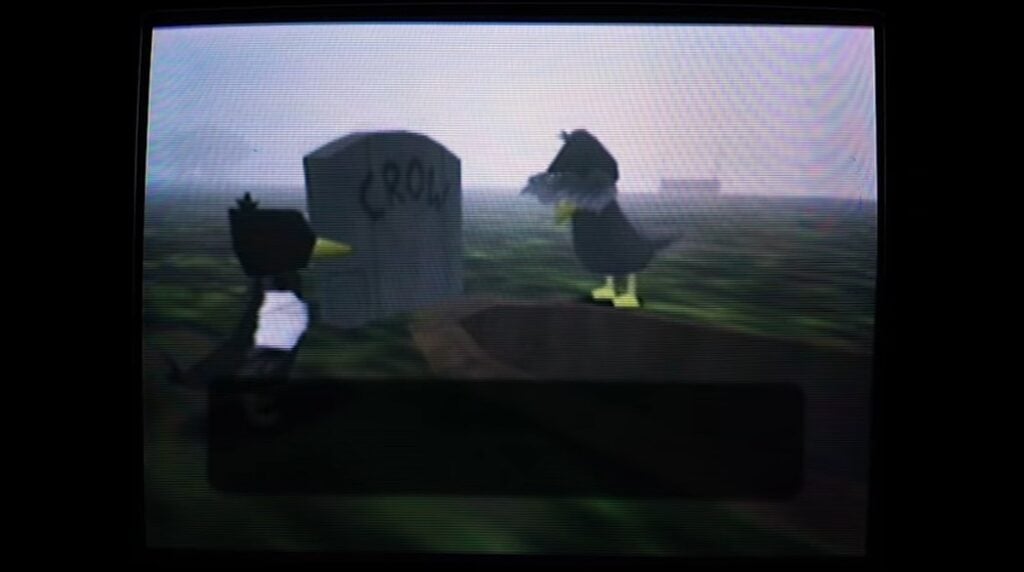
Many questions still remain about Catastrophe Crow. Whether Lorenz intended the game to be a metaphorical means of ensuring Thea’s survival or a literal one remains to be seen. The same is true of whether Lorenz is really dead or not — and of whether the Crow 64 saga is meant to be a classic “haunted cartridge” tale (in which case, the question becomes whether it’s haunted by Lorenz, by Thea, or possibly by both).
Personally, I don’t read the story as a haunted cartridge tale; I disagree with the speculated story that’s the prevailing theory within the community these days in that I think it’s a little subtler than that. I like reading the story less literally — although I don’t discount the possibility that Lorenz was trying to imbue Catastrophe Crow with actual revival properties.
(I haven’t dug too far into this here, as it’s not what this piece is focused on — you can check the various Google docs and/or some of the videos from media analysis YouTubers for more on the theory — but the TL;DR is, there’s a lot of Egyptian imagery and iconography scattered throughout the Crow 64 story, especially in the later additions: A video posted to the Ultra 64 Forever account on Dec. 5 featured hieroglyphics and Crow ascending upwards through a pyramid-shaped environment; the email sent that same day included the coded pyramid image; and an image of an ankh was decoded from the data dump. All of this suggests a focus not just on death, but on life after death — even if that afterlife occupies a different plane of existence.)
But that’s just me. The beauty of this story is that it can be read in so many different ways, many of which make perfect sense — and that, I think, speaks to its strength as a piece of storytelling.
In fact, ultimately, Crow 64 is, as a whole, an excellent example of how to pull of an ARG in the most effective way possible. The story is full and complete, with a clear roadmap and an endpoint in mind — not something that’s just been slapped together or made up on the fly. There’s plenty to dig into for those who love diving into the details and minutiae — but you also don’t need to solve every single puzzle in order to understand what’s going on.
And, perhaps most importantly is this: There are just enough answers and beats to make the story make sense — but it still leaves many aspects of the narrative open to interpretation. I may read it as a cartridge-as-communication story, and possibly a cartridge-as-esoteric-revival-system story — but it also reads perfectly well as a haunted cartridge story. Viewers and players are free to take away from Crow 64 whatever resonates with them the most.
There may or may not be any more drops regarding Crow 64 — but I don’t think we’ve heard the last of it either. When the finale comes — and I do believe it will come, and that it will end the tale with a definite punctuation mark — we’ll know. We’ll have found out precisely what happened to Catastrophe Crow and the Lorenz family, and where they both stand now.
Because that’s always been the point. That’s what Butcher told us to examine right from the start, isn’t it?: “What Happened To Crow 64?”
In the meantime, the complete findings Google doc can be found here, and the subreddit introduction and Discord invite here. For a complete playlist of all known Crow 64 videos so far, head here.
Give it a look.
See what you can make of it.
Good luck.
***
Follow The Ghost In My Machine on Twitter @GhostMachine13 and on Facebook @TheGhostInMyMachine. And don’t forget to check out Dangerous Games To Play In The Dark, available now from Chronicle Books!
[Photos via Adam Butcher, 90sRetroGamingFRed, N64ExcavationMan, 3D Platformers NZ/YouTube; hero image remixed by Lucia Peters]